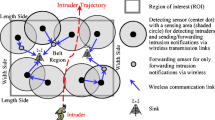Abstract
Recently, the barrier coverage was proposed and received much attention in wireless sensor network (WSN), and the degree of the barrier coverage, one of the critical parameters of WSN, must be re-studied due to the difference between the barrier coverage and blanket coverage. In this paper, we propose two algorithms, namely, local tree based no-way and back (LTNWB) algorithm and sensor minimum cut sets (SMCS) algorithm, for the opened and closed belt regions to determine the degree of the barrier coverage of WSN. Our main objective is to minimize the complexity of these algorithms. For the opened belt region, both algorithms work well, and for the closed belt region, they will still come into existence while some restricted conditions are taken into consideration. Finally, the simulation results demonstrate the feasibility of the proposed algorithms.
Similar content being viewed by others
References
Wang Y C, Hu C C, Tseng Y C. Efficient deployment algorithms for ensuring coverage and connectivity of wireless sensor networks [C]//Wireless Internet, 2005. Proceedings. First International Conference on. Nat Chiao Tung Univ., Hsinchu, Taiwan: [s.n.], 2005: 114–121.
Bai X, Kumar S, Xuan D, et al. Deploying wireless sensors to achieve both coverage and connectivity [C]//Proceedings of the 7th ACM International Symposium on Mobile Ad Hoc Networking and Computing. Florence, Italy: [s.n.], 2006: 131–142.
Zou Y, Chakrabarty K. Sensor deployment and target localization based on virtual forces [C]//INFOCOM, Twenty-Second Annual Joint Conference of the IEEE Computer and Communications Societies. [s.l.]: IEEE, 2003: 1293–1303.
Wang G, Cao G, Porta T L. Movement-assisted sensor deployment [J]. IEEE Transaction on Mobile Computing, 2004, 4: 2469–2479.
Sriram C, Bai X, Ma B, et al. Mobility limited flipbased sensor networks deployment [J]. Parallel and Distributed Systems, IEEE Transactions on, 2007, 18: 199–211.
Wu J, Yang S. SMART: A scan-based movement-assisted sensor deployment method in wireless sensor networks [C]//The 24th Annual Joint Conference of the IEEE Computer and Communications Societies, Proceedings IEEE. [s.l.]: IEEE, 2005: 2313–2324.
Santosh K, Lai T H, Anish A. Barrier coverage with wireless sensors [C]//International Conference on Mobile Computing and Networking, Proceeding of the 11th Annual International Conference. Cologne, Germany: [s.n.], 2005: 284–298.
Santosh K, Lai T H, J’ozsef B. On k-coverage in a mostly sleeping sensor network [C]//International Conference on Mobile Computing and Networking, Proceedings of the 10th Annual International Conference, Mobile Computing and Networking. Philadelphia, PA, USA: [s.n.], 2004: 144–158.
Author information
Authors and Affiliations
Corresponding author
Rights and permissions
About this article
Cite this article
Pei, Zq., Xu, Cq. & Teng, J. A study on the degree of barrier coverage in wireless sensor networks. J. Shanghai Jiaotong Univ. (Sci.) 14, 497–502 (2009). https://doi.org/10.1007/s12204-009-0497-1
Received:
Published:
Issue Date:
DOI: https://doi.org/10.1007/s12204-009-0497-1
Key words
- wireless sensor network (WSN)
- barrier coverage
- local tree based no-way and back (LTNWB)
- sensor minimum cut sets (SMCS)




